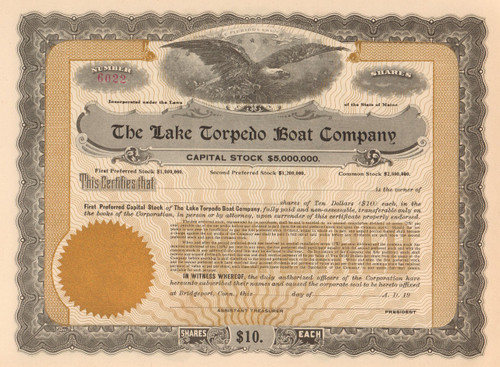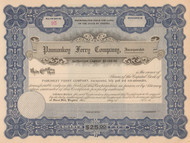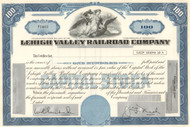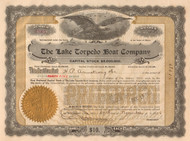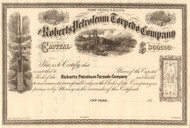Categories
Categories
Lake Torpedo Boat Company unissued circa 1916 (early submarines)
Product Description
Lake Torpedo Boat Company stock certificate 1916
Great historical piece with a nice eagle vignette. Unissued and not cancelled. Circa 1916 from issued examples.
Incorporated in Maine, The Lake Torpedo Boat Company of Bridgeport, Connecticut was an early builder of submarines for the United States Navy. Founded by Simon Lake in 1912, the firm competed with John Philip Holland's Electric Boat Company until financial difficulties led to the company's demise in 1924.
The Navy ceased awarding contracts to Lake shortly before that time, partly because USS S-2 (SS-106), the company's entry in the S-class submarine design competition, was not selected for further production. Only five S-boats were built by Lake. Also, the yard was not physically able to build the large submarine cruisers then envisioned, such as USS Argonaut (SM-1). The Washington Naval Treaty's limits on submarines were also a major factor. At the time, the Navy wished to concentrate submarine construction at Navy Yards, particularly Portsmouth Navy Yard in Kittery, Maine.
The company completed 26 submarines for the US Navy, designed two US Navy submarines that were built in other yards, and built several other submarines for civilian use or that were not accepted by the Navy. Some of the submarines built by Lake for the Navy included several L-class, O-class, and R-class submarines. The company designed the Imperial Russian Navy's Osetr-class submarines, the first of which was Lake's Protector. The Kaiman-class submarines were also designed for Russia.
Simon Lake
Simon Lake (1866 – 1945) was a Quaker American mechanical engineer and naval architect who obtained over two hundred patents for advances in naval design and competed with John Philip Holland to build the first submarines for the United States Navy.
He built his first submarine, Argonaut Junior, in 1894 in response to an 1893 request from the US Navy for a submarine torpedo boat. In 1898 he followed up with the 36-foot Argonaut 1, which he sailed from Norfolk, Virginia for a thousand miles to Sandy Hook, New Jersey, arriving in November, 1898. As a result of lessons learned on that journey, he rebuilt it into the 60-foot Argonaut 2.
Neither Argonaut nor Lake's following submarine, Protector, built in 1901, were accepted by the Navy. Protector was the first submarine to have diving planes mounted forward of the conning tower and a flat keel. Four diving planes allowed Protector to maintain depth without changing ballast tank levels, and to dive level without a down-angle. Level diving was a feature of several subsequent Lake designs, notably the first three US G-class submarines. Protector also had a lock-out chamber for divers to leave the submarine. Lake, lacking Holland's financial backing, was unable to continue building submarines in the United States. He sold Protector to Imperial Russia in 1904 as the Osetr and spent the next seven years in Europe designing submarines for the Austro-Hungarian Navy, Germany's Kaiserliche Marine, and the Imperial Russian Navy.
He lived in Milford, Connecticut from 1907 until his death in 1945. In 1912, he founded the Lake Torpedo Boat Company in Bridgeport, Connecticut, which built 26 submarines for the United States Navy during and after World War I. Lake's first submarine for the U.S. Navy, USS G-1 (SS-19½), set a depth record of 256 feet in November 1912.
In 1922 the United States and other countries signed treaties limiting the size of their navies. This led to financial difficulties which forced the Lake Torpedo Boat Company to close in the mid-1920s. Following the company's closure, Lake continued designing maritime salvage systems including obtaining permission to partially salvage the Lusitania off the south Irish coast and then later a failed attempt to salvage gold from HMS Hussar, a British frigate that sank in 1780 in New York's East River with his submarine, the Explorer. Lake redesigned the former USS O-12 (SS-73) as the Arctic exploration submarine Nautilus, used by Sir Hubert Wilkins in a 1931 expedition. He also advised the United States Navy on submarine technology and maritime salvage during World War II.
 Loading... Please wait...
Loading... Please wait... 
